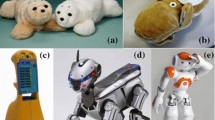Abstract
Many studies on social interaction have used the humanoid robot NAO. In the present paper, we described our project designed to address the growing unmet need for alternative approaches to slowing the progression of cognitive decline in Mild Cognitive Impairment patients. NAO is the experimental platform used in an ecological setting: a center for the treatment of cognitive disorders and dementia of the Italian health service. This paper describes the study addressed to evaluate the effectiveness of human–robot interaction to reinforce therapeutic behavior and treatments adherence and presents the latest findings of functional tests and users investigation recently conducted. The robot was programmed to implement some tasks from the usual memory-training program protocol. In different training conditions, subjects participated in sessions with the support of NAO or only from the psychologist while the interaction was recorded for subsequent exploration. Data indicated that memory training with NAO resulted in an increase of visual gaze from patients and reinforce of therapeutic behavior reducing, in some cases, depressive symptoms. Unexpectedly, significant changes in prose memory and verbal fluency measures were detected. These findings suggest that further research on robotics in ecological settings is necessary to determine the extent to which they can effectively support clinical practice.






Similar content being viewed by others
References
Bäck I, Makela K, Kallio J (2013) Robot-guided exercise program for the rehabilitation of older nursing home residents. Annal Long Term Care 21(6):38–41
Boissy P, Corriveau H, Michaud F, Labonté D, Royer MP (2007) A qualitative study of in-home robotic telepresence for home care of community-living elderly subjects. J Telemed Telecare 13(2):79–84
Brooke, J.: Sus: A quick and dirty usability scale. In: T. B., W. A., M.I. I. (eds.) JordanP. W., pp. 189–194 (1996)
Cohen-Mansfield J, Dakheel-Ali M, Marx MS (2009) Engagement in persons with dementia: the concept and its measurement. Am J Geriatr Psychiatry 17(4):299–307. https://doi.org/10.1258/135763307780096195
Crook TH, Feher EP, Larrabee GJ (1992) Assessment of memory complaint in age associated memory impairment: the mac-q. Int Psychogeriatr 4(2):165–176
De Carolis B, Ferilli S, Palestra G (2015) Improving speech-based human robot interaction with emotion recognition. In: International symposium on methodologies for intelligent systems, Springer, pp 273–279
De Carolis B, Ferilli S, Palestra G (2017) Simulating empathic behavior in a social assistive robot. Multimed Tools Appl 76(4):5073–5094. https://doi.org/10.1007/s11042-016-3797-0
De Carolis BN, Ferilli S, Palestra G, Carofiglio V. Towards an empathic social robot for ambient assisted living. In: ESSEM@ AAMAS, pp 19–34. URL https://dl.acm.org/citation.cfm?id=3054107
Ertuğrul BS, Gurpinar C, Kivrak H, Kose H (2013) Gesture recognition for humanoid assisted interactive sign language tutoring. In: Signal processing and communications applications conference (SIU), pp 1–4
Gallese V, Keysers C, Rizzolatti G (2004) A unifying view of the basis of social cognition. Trends Cognitive Sci 8(9):396–403. https://doi.org/10.1016/j.tics.2004.07.002
Gauthier S, Reisberg B, Zaudig M, Petersen RC, Ritchie K, Broich K, Belleville S, Brodaty H, Bennett D, Chertkow H et al (2006) Mild cognitive impairment. Lancet 367(9518):1262–1270. https://doi.org/10.1016/S0140-6736(06)68542-5
Gazzola V, Rizzolatti G, Wicker B, Keysers C (2007) The anthropomorphic brain: the mirror neuron system responds to human and robotic actions. Neuroimage 35(4):1674–1684. https://doi.org/10.1016/j.neuroimage.2007.02.003
Gollin D, Ferrari A, Peruzzi A (2007) Una palestra per la mente. stimolazione cognitiva per l’invecchiamento cerebrale e le demenze. Edizioni Erickson, Trento
Gollin D, Ferrari A, Peruzzi A (2011) Una palestra per la mente. Erickson Ed, Trento
Graf B, Parlitz C, Hägele M (2009) Robotic home assistant care-o-bot® 3 product vision and innovation platform. In: International conference on human–computer interaction, Springer, pp 312–320
Gross HM, Schroeter C, Mueller S, Volkhardt M, Einhorn E, Bley A, Langner T, Martin C, Merten M (2011) I’ll keep an eye on you: Home robot companion for elderly people with cognitive impairment. In: Systems, man, and cybernetics (SMC), 2011 IEEE international conference on, pp 2481–2488
Gross HM, Schroeter C, Mueller S, Volkhardt M, Einhorn E, Bley A, LangnerT, Merten M, Huijnen C, van den Heuvel H, et al. (2012) Further progress towards a home robot companion for people with mild cognitive impairment. In: Systems, man, and cybernetics (SMC), 2012 IEEE international conference on, pp 637–644
Jutai J, Day H (2002) Psychosocial impact of assistive devices scale (PIADS). Technol Disabil 14(10):107–111
Kidd CD, Breazeal C (2008) Robots at home: understanding long-term human–robot interaction. In: Intelligent robots and systems, IROS 2008. IEEE/RSJ international conference on, pp 3230–3235
Martín F, Agüero C, Cañas JM, Abella G, Benítez R, Rivero S, Valenti M, Martínez-Martín P (2013) Robots in therapy for dementia patients. J Phys Agents 7(1):48–55
McDuff D, Mahmoud A, Mavadati M, Amr M, Turcot J, Kaliouby Re (2016) Affdexsdk: a cross-platform real-time multi-face expression recognition toolkit. In: Proceedings of the 2016 CHI conference extended abstracts on human factors in computing systems, pp 3723–3726. ACM . https://doi.org/10.1145/2851581.2890247
Montazeri A, Vahdaninia M, Ebrahimi M, Jarvandi S (2003) The hospital anxiety and depression scale (hads): translation and validation study of the iranian version. Health Quality Outcomes 1(1):14
Moyle W, Jones C, Cooke M, O’Dwyer S, Sung B, Drummond S (2014) Connecting the person with dementia and family: a feasibility study of a telepresence robot. BMC Geriatr 14(1):7. https://doi.org/10.1186/1471-2318-14-7
Noldus (2014) Facereader: tool for automatic analysis of facial expression: Version 6.0
Novelli G, Papagno C, Capitani E, Laiacona M (1986) Tre test clinici di ricerca e produzione lessicale. Taratura su sogetti normali. Archivio di Psicologia, Neurologia e Psichiatria. 477–506
Novelli P, Capitani L, Vallar C, Cappa S (1986) Test di fluenza verbale. Archivio di Psicologia, Neurologia e Psichiatria 47(4)
Orsini A, Grossi D, Capitani E, Laiacona M, Papagno C, Vallar G (1987) Verbal and spatial immediate memory span: normative data from 1355 adults and 1112 children. Italian J Neurolo Sci 8(6):537–548
Palestra G, Pettinicchio A, Del Coco M, Carcagn`ı P, Leo M, Distante C (2015) Improved performance in facial expression recognition using 32 geometric features. In: International conference on image analysis and processing, Springer, pp 518–528
Perugia G, van Berkel R, D´ıaz-Boladeras M, Catal`a-Mallofr´e A, Rauterberg M, Barakova E (2018) Understanding engagement in dementia through behavior. The ethographic and laban-inspired coding system of engagement (elicse) and the evidence-based model of engagement-related behavior (emodeb). Frontiers in psychology 9 https://doi.org/10.3389/fpsyg.2018.00690
Petersen RC (2007) Mild cognitive impairment: current research and clinical implications. In: Seminars in neurology, vol 27. Copyright© 2007 by Thieme Medical Publishers, Inc, New York, pp 022–031
Pino O (2015) Memory impairments and rehabilitation: evidence-based effects of approaches and training programs. Open Rehabilit J 8(1)
Pino O (2017) Ricucire i ricordi: la memoria, i suoi disturbi, le evidenze di efficacia dei trattamenti riabilitativi. Mondadori universit`a
Pino O, Cadena R (2018) Will humanoid robots become an assistive technology for people with special needs. J Alzheimers Dement 1(001):2. https://doi.org/10.21767/IPAD.100001
Pino O, Poletti F, Caffarra P (2013) Cognitive demand and reminders effect on time-based prospective memory in amnesic mild cognitive impairment (amci) and in healthy elderly. Open J Med Psychol 2(01):35. https://doi.org/10.4236/ojmp.2013.21007
Sabanovic S, Bennett CC, Chang WL, Huber L (2013) Paro robot affects diverse interaction modalities in group sensory therapy for older adults with dementia. In: Rehabilitation robotics (ICORR), 2013 IEEE international conference on, pp 1–6
Spielberger CD (1983) State-trait anxiety inventory for adults. PsycTESTS Dataset https://doi.org/10.1037/t06496-000
Spinnler H (1987) Standardizzazione e taratura italiana di test neuropsicologici. Ital J NeurolSci 6:21–120
Ton TG, DeLeire T, May SG, Hou N, Tebeka MG, Chen E, Chodosh J (2017) The financial burden and health care utilization patterns associated with amnestic mild cognitive impairment. Alzheimer’s Dementia 13(3):217–224. https://doi.org/10.1038/s41598-018-21983-w
Vital JP, Couceiro MS, Rodrigues NM, Figueiredo CM, Ferreira NM (2013) Fostering the nao platform as an elderly care robot. In: 2013 IEEE 2nd international conference on serious games and applications for health (SeGAH), pp 1–5
Acknowledgements
Authors would like to thank the participants who gave their time generously to the study, the clinical teams who supported recruitment to the project, in particular Beatrice Pagliara from the Center of Cognitive Impairments and Dementia of Parma, Italy.
Author information
Authors and Affiliations
Contributions
OP and RT cooperated and contributed to the design and plan of the present study. RT was in charge for data acquisition, analysis and manuscript writing. GP and BDC was in charge of software assessments and analysis. OP and BDC were in charge of manuscript verifying.
Corresponding author
Ethics declarations
Conflict of interest
The authors declare that they have no conflict of interest.
Additional information
Publisher’s Note
Springer Nature remains neutral with regard to jurisdictional claims in published maps and institutional affiliations.
Rights and permissions
About this article
Cite this article
Pino, O., Palestra, G., Trevino, R. et al. The Humanoid Robot NAO as Trainer in a Memory Program for Elderly People with Mild Cognitive Impairment. Int J of Soc Robotics 12, 21–33 (2020). https://doi.org/10.1007/s12369-019-00533-y
Accepted:
Published:
Issue Date:
DOI: https://doi.org/10.1007/s12369-019-00533-y




